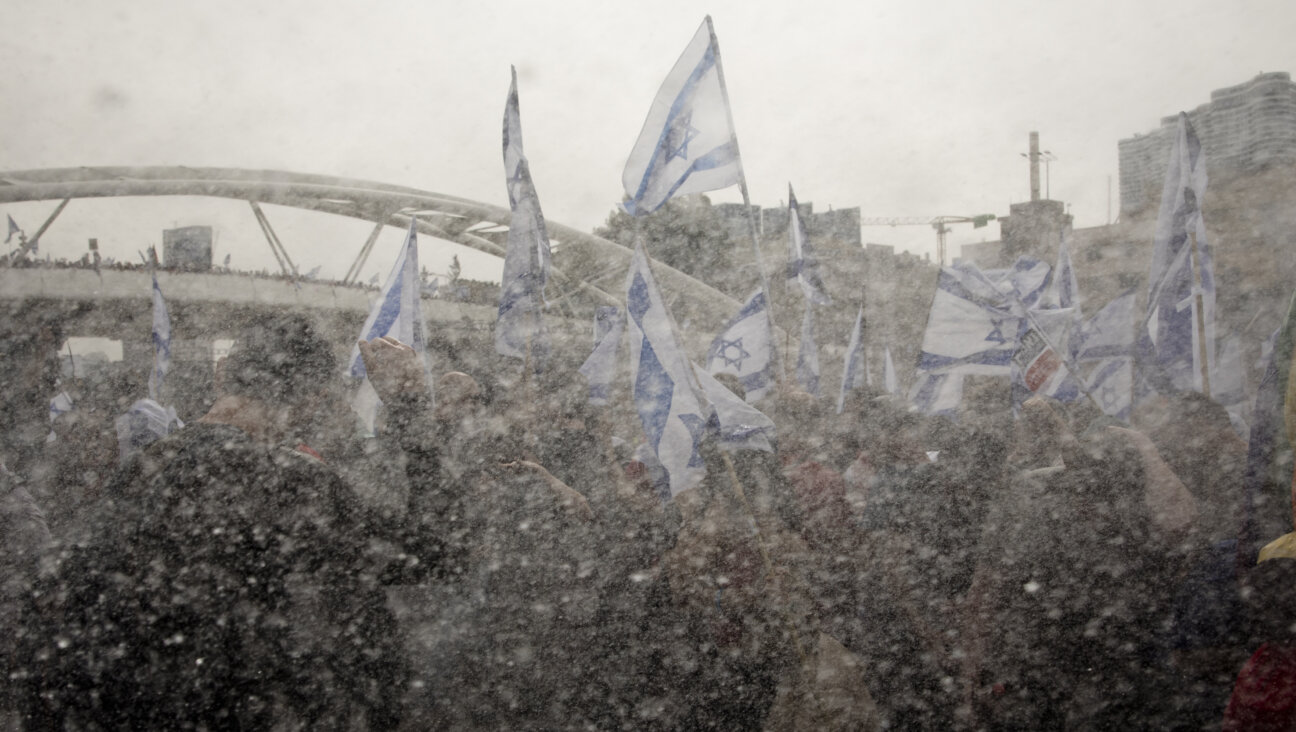Concentration Camp Artist’s Mini-Masterpieces Get New Life — Thanks To Daughters

A photograph of Joseph and Rebecca Bau leans against Joseph Bau’s work table in his Tel Aviv studio. Image by Naomi Zeveloff
Joseph Bau moved into the Krakow ghetto with a case filled with brushes and paints, in which he fashioned a double bottom to hide precious family photographs.
In the ghetto, and later in the Płaszów concentration camp, he created drawings and poetry on the paper he collected from cigarette butts thrown aside by the Nazis. He crafted tiny books and stowed them away in the secret compartment, a personal record of his own hope and despair.
Bau’s case was confiscated when the Nazis closed Płaszów and sent the Jewish inmates to Auschwitz and other camps. One of the lucky ones to make it onto Oskar Schindler’s list — Bau’s clandestine wedding to Rebecca Tannenbaum is depicted in Steven Spielberg’s 1993 film — Bau was reunited with his case after Schindler found it in a storage facility. He immediately opened the secret compartment to find his little books and photographs intact.
Now the case is the inspiration for a new project by Bau’s Israeli daughters, Hadassah Bau and Clila Bau-Cohen. Timed with Holocaust Memorial Day on April 24, the sisters have published a collection of three books containing both their mother’s and their father’s writing in a black case meant to evoke the one their father carried.

The new book project based on the stories of Joseph and Rebecca Bau. Image by Courtesy Clila Bau-Cohen
Two of the three books are Hebrew translations of their mother and father’s personal writing in Polish, including expressions of love and longing between the couple that defied the odds to wed in the Płaszów camp. The last, hidden in a secret compartment, is a replica of one of Bau’s cigarette paper books, written in tiny Polish lettering.
“It is a surprise for the reader,” Bau-Cohen said. “We wanted the reader to have the feeling and the experience of holding in his hand a tiny book to see how small it was and what tiny handwriting and the beautiful drawings.”
One of the included poems, “The Parting,” is one that Bau wrote to Rebecca Bau as a goodbye. “Our roads will yet meet again,” he wrote.
Rebecca and Josef Bau met in the Płaszów camp just days after Bau watched his father’s murder at the hands of a Nazi. Bau, who worked for the camp’s commander making maps and drafting documents, was asked to make a copy of a map by using a technique that involved sun exposure. Panicked because it was a cloudy day, Bau went outside and aimed the map at the sky, praying for sun. Just then, a young woman walked by and asked him what he was doing. Bau explained that he was waiting for the sun to come out, and then he flirtatiously suggested that she could serve as a substitute. Miraculously, the copy came out.
Bau risked his life to marry his “sun” when he sneaked into the women’s side of the camp wearing a kerchief typical of female prisoners. He had starved himself for two weeks, trading bread for a silver spoon and the services of a jeweler to make two wedding rings.
Later, Bau’s wife would save him by submitting his name in place of her own on a coveted spot on Schindler’s list while she was shipped off to Auschwitz. After the war, Bau found his wife in a hospital, where she was recuperating from an injury. In 1950 the pair immigrated to Israel, where Bau became one of the country’s most inventive graphic artists. His daughters call him the Walt Disney of Israel. The Baus have both passed away.
Today, Hadassah Bau and Bau-Cohen tell their parents’ story on tours of their father’s Tel Aviv studio, which they have turned into a museum. Their new book project is a testament to their relationship, a “love story inside that black horrible place,” Bau-Cohen said.
She said it is a “box of love.”
Contact Naomi Zeveloff at [email protected] or on Twitter, @naomizeveloff
A message from our Publisher & CEO Rachel Fishman Feddersen

I hope you appreciated this article. Before you go, I’d like to ask you to please support the Forward’s award-winning, nonprofit journalism so that we can be prepared for whatever news 2025 brings.
At a time when other newsrooms are closing or cutting back, the Forward has removed its paywall and invested additional resources to report on the ground from Israel and around the U.S. on the impact of the war, rising antisemitism and polarized discourse.
Readers like you make it all possible. Support our work by becoming a Forward Member and connect with our journalism and your community.
— Rachel Fishman Feddersen, Publisher and CEO
























